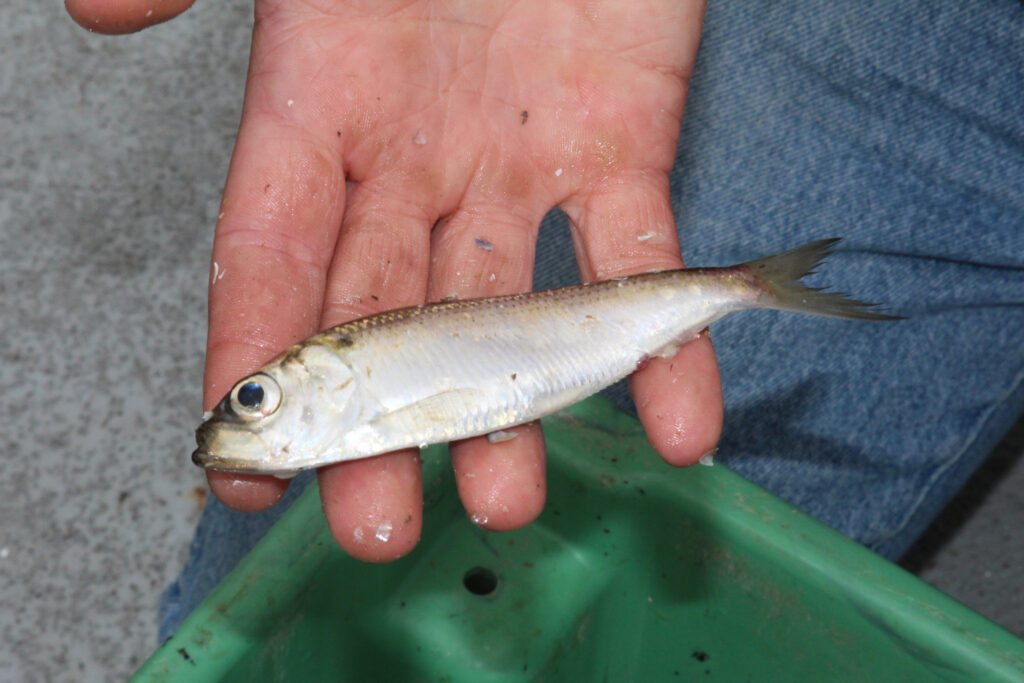Bill Cooksey-Bass Pro reward-Credit Ron Wong-600
Do you have any thoughts on this post?
The New England Fishery Management Council is soliciting public comments to develop new management measures for this critical forage fish
The Atlantic herring stock is currently considered overfished, at a mere one-fifth of its target biomass. While the total herring harvest has decreased over the years, economic and on-the-water conflicts still abound between industrial midwater trawlers and other groups in New England who are reliant on a healthy herring resource, such as recreational anglers, other commercial watermen, and ecotourism operators.
Atlantic mackerel, a primary alternative prey species for herring predators – and harvested by essentially the same trawling fleet – have also crashed. In addition, the high volume of bycatch of already depleted species like river herring and shad, which are caught by the industrial herring fleet year-round, has prompted scientists and managers to ask two important questions:
What more can be done to mitigate bycatch from the directed herring fishery, and how can we enhance efforts to restore and maintain runs of river herring and shad?
Previous Protections Vacated in Court
Many New England anglers might remember the nearly decade-long process that was Amendment 8 to the Atlantic Herring Fishery Management Plan. From 2015 to 2021, anglers and conservationists helped provide input toward the development of a 12-mile-wide “Inshore Midwater Trawl Restricted Area” as part of the amendment. This buffer zone protected nearshore areas in New England from the impacts of industrial midwater trawling, allowing recreational anglers and smaller-scale commercial gear types enhanced access to herring for bait, and leaving more forage in the water for herring lovers like striped bass, tuna, whales, and many more.
Unfortunately, that buffer zone was short-lived; vacated in 2022 because the court determined that the rationale for its establishment – localized depletion of the herring resource – couldn’t be scientifically proven. So, it might come as no surprise that the issues prompting the buffer zone’s development nearly ten years ago still persist in 2024, and now there’s an effort to re-establish similar restrictions within the fishery.

A Renewed Attempt to Protect Herring
In 2023, the New England Fishery Management Council began working in earnest to prioritize the development of new management measures through a new amendment to the Fishery Management Plan – Amendment 10 – to address the ongoing concerns, attain optimum yield in the fishery, and improve herring’s conservation status. Last year, the Theodore Roosevelt Conservation Partnership and partners launched a new campaign to work alongside the council to support Amendment 10 action and ensure that access to a healthy herring population is available to all stakeholders.
The council has since decided to explore a range of management alternatives to “minimize user conflicts, including spatially and temporally explicit gear restrictions, area closures, and possession limits.” Potential management measures it will consider include the spatial extent of the Midwater Trawl Restricted Area approved under Amendment 8, and a focus on areas not subject to current seasonal closures to midwater trawling.
What You Need to Know
The NEFMC is now soliciting public comments about which direction it should take when developing and implementing new management measures in the Atlantic herring fishery. The council is proposing to take action by addressing the spatial (location-based) and temporal (seasonal-based) allocation and management of this species at the management unit level. They have also produced a scoping document with a full list of questions for the public to consider when providing input, which can be found here.
In short, Amendment 10 management measures will be designed to attain optimum yield and improve the conservation status of Atlantic herring by accounting for its critically important role as a forage species; minimizing user conflicts; and addressing the incidental catch of river herring and shad by the directed Atlantic herring fishery.

How You Can Help
There are two ways to let the council know which restrictions would improve your access to a healthy herring resource in your area: in-person comments at one of six scoping meetings, or written comments sent in via email.
From March 1 to April 22, the NEFMC is hosting in-person meetings in all coastal New England states, with two webinar options. The TRCP highly encourages you to attend your state’s hearing as the most effective means to convey your concerns. The full meeting schedule is available here. Alternatively, anyone can submit written comments via email during the scoping period from March 1 until 8 a.m. April 30. We have provided a simple prompt and talking points for you to email written comments directly to the council through this .
Some tips for making public comments:
It’s critical that anglers and conservationists let their voices be heard during this process. Whether you provide a quick email comment, or attend an in-person meeting in your state, your input is vital to the NEFMC so that they can develop management measures that equitably allocate the herring resource among all stakeholders.
Last but not least, if you have ever experienced conflicts with the industrial herring fleet, we encourage you to fill out this anonymous survey, which will be used to help determine where those user conflicts take place and their impacts. Responses will be analyzed to understand the nature and severity of conflicts with the herring fleet, which could inform the design of one or more new buffer zones to reflect the needs of recreational and commercial anglers and other ocean users.
More on Forage Fish Conservation
For more information about the TRCP’s work on forage fish along the Atlantic and Gulf coasts, click here. As always, feel free to reach out to me at jhiggins@trcp.org with further questions, or if you would like to get more involved with any of our campaigns.
Learn more about forage fish recovery efforts.
Top photo credit: Chesapeake Bay Program/Will Parson
In this short video, we demystify a crucial Farm Bill conservation program, the Agricultural Conservation Easement Program (ACEP), and shed light on its benefits to hunters and anglers.
This program helps to protect wetlands, grasslands, and working farms and ranches through conservation easements.
ACEP easements keep working lands working, ensuring farms and ranches in key areas are not developed or subdivided and maintaining their value for wildlife. By protecting and enhancing wetlands, ACEP easements not only provide prime habitat for waterfowl and other important species, but also sequester carbon, improve water quality, mitigates impacts of flooding, and maintain surface water during dry spells.
The Farm Bill is the largest piece of conservation legislation that will come before the 118th Congress. You can help ensure that habitat and wildlife remain central to sensible farm policy in the United States here
Learn more about Farm Bill Conservation Programs here
The BLM’s final plan secures safeguards for over 400,000 acres of backcountry
Today, the Bureau of Land Management officially announced the release of the Record of Decision for the Southeast Oregon Resource Management Plan Amendment, marking a pivotal moment for conservation in Oregon. This final plan, set to guide land management across more than 4.6 million acres of an iconic Oregon landscape, strikes a thoughtful balance between habitat conservation, outdoor recreation, grazing, and development.
This significant milestone represents the culmination of over 20 years of dedicated planning and collaborative stakeholder engagement. The Theodore Roosevelt Conservation Partnership joins hunters and anglers in celebrating the 420,000 acres within the plan’s jurisdiction that will now be managed to maintain their wild, backcountry character.
“Today’s announcement is a testament to the power of collaborative and persistent stakeholder engagement with a shared commitment to conserving our state’s wild and diverse landscapes,” said Tristan Henry, Oregon field representative for Theodore Roosevelt Conservation Partnership. “We are particularly proud of our role in shaping a management strategy that recognizes the importance of these lands for wildlife habitat and outdoor recreation, including hunting and fishing.”
The finalized plan reflects the recommendations of the Southeast Oregon Resource Advisory Council, a diverse group of stakeholders—including hunters, anglers, and ranchers—who have provided invaluable insights throughout the planning process.
“To help guide the development of this plan, a broad-based BLM resource advisory council, made up of 15 appointed individuals, rolled up their sleeves to create a well-rounded alternative within the Southeast Oregon RMP amendment,” said Michael O’Casey, deputy director of forest policy and northwest programs for the TRCP and a current Southeast Oregon RAC member. “We are thrilled to see the BLM utilize many of the recommendations provided by the RAC to conserve special places from development, while providing for public access, habitat restoration, and ranching to continue.”
The ROD emphasizes the significance of the Owyhee and Malheur River regions as vital habitats for wildlife and as premier destinations for outdoor enthusiasts. By prioritizing conservation and balanced land use, the BLM’s plan ensures that these areas will continue to support Oregon’s rich traditions of fish-and-wildlife-based economy, which is integral to the state’s $2.5 billion outdoor recreation industry.
The conservation community and outdoor recreation advocates have long championed a balanced approach to land management that safeguards wildlife habitat while allowing for sustainable use. The TRCP, Backcountry Hunters & Anglers, Oregon Hunters Association, Trout Unlimited, and members of the Owyhee Sportsmen’s Coalition have been instrumental in advocating for these principles throughout the planning process.
“We applaud the BLM’s foresight in preserving the vitality of the Owyhee and Malheur regions. This plan is a testament to the power of collaboration and dedication of organizations and individuals who stand for balanced land use,” affirmed Chris Hagar, northwest coordinator for Backcountry Hunters & Anglers. “It’s a significant step forward in ensuring our public lands continue to flourish for future generations of Oregonians and wildlife alike.”
The TRCP and the Owyhee Sportsmen look forward to continued collaboration with the BLM, state officials, and all stakeholders to implement this plan and further the legacy of conservation, restoration, and stewardship for future generations.
Photo Credit: Brian Grossenbacher
In this short video, we demystify a crucial Farm Bill conservation program, the Environmental Quality Incentives Program (EQIP), and shed light on its benefits to hunters and anglers.
EQIP is a voluntary conservation program that allows farmers, ranchers, and forest landowners to enhance water quality, strengthen wildlife habitat, and reduce soil erosion and sedimentation.
The benefits of EQIP for fish, wildlife and agriculture are significant.
The Farm Bill is the largest piece of conservation legislation that will come before the 118th Congress. You can help ensure that habitat and wildlife remain central to sensible farm policy in the United States here
Learn more about Farm Bill Conservation Programs here
Theodore Roosevelt’s experiences hunting and fishing certainly fueled his passion for conservation, but it seems that a passion for coffee may have powered his mornings. In fact, Roosevelt’s son once said that his father’s coffee cup was “more in the nature of a bathtub.” TRCP has partnered with Afuera Coffee Co. to bring together his two loves: a strong morning brew and a dedication to conservation. With your purchase, you’ll not only enjoy waking up to the rich aroma of this bolder roast—you’ll be supporting the important work of preserving hunting and fishing opportunities for all.
$4 from each bag is donated to the TRCP, to help continue their efforts of safeguarding critical habitats, productive hunting grounds, and favorite fishing holes for future generations.
Learn More
